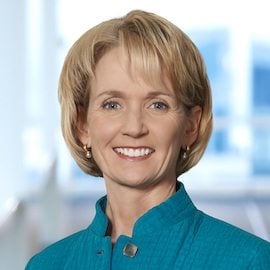How She Got There: Alison Quirk’s Path to Becoming Executive Vice President at State Street Corporation

Yes, loved, in the past tense, because Quirk actually retired earlier this year at age 55 (!). “I wasn’t learning new things, but it was too hard to sort out the next chapter while doing my job,” she says. “So I gave notice and started to groom my replacement two years ago.” Just back from a month in Italy, Quirk is currently doing a little consulting while exploring corporate board work. We’re sure her next act will be as impressive as her last, but in the meantime, here, in our latest installment profiling board members’ careers, are Quirk’s steps to becoming executive vice president and chief human resources and citizenship officer at State Street.
Initial Dream Job
“I didn’t know what I wanted to do even in college. I majored in communications at the University of New Hampshire, but took a lot of business classes. I probably should have switched to the business school. I loved the courses about organizational development and behavior, marketing and sales.”
Proverbial Fork in the Road
“After graduation, I had two job offers: one in advertising sales and the other as a compensation and benefits administrator. The first paid more, but during the interviewing process, I realized that human resources was probably a better fit for my interests.”
Staying Put for 16+ Years
“After a couple of years, I moved to recruiting at Boston Financial Data Services, which I liked a lot. It had elements of sales and a lot of people interaction with hiring managers and candidates. I really enjoyed that, and moved on to become manager of the department. Ultimately, I headed HR as well as took on responsibilities in public relations, marketing and community affairs—and five or so years ago, I came full circle and joined the board.
“Early on, I learned how to be useful and add value by offering to do extra things like cover the receptionist when she was out or do orientations for new employees. I was volunteering because I wanted to know more, but it was noticed and appreciated and led to my getting more responsibility.”
Changing Companies
“There were probably four points at Boston Financial when I was recruited or thought about leaving. But I stayed because the company was growing and started acquiring other companies, which gave me new experiences and skills with every acquisition. I also had a young family, and I didn’t want to take the risk of changing jobs when I liked my job and it was still good for my career. I finally leapt to be senior vice president of human resources and corporate administration at Liberty Financial Services. It was a multi-boutique asset management firm, and I wanted to learn about the business. A year to the day I started, though, it was announced that the company was being sold, and a year after that, we were all laid off. I thought I’d made the biggest mistake of my life, but it turns out that being in the company that was sold was a good experience for me. I saw what it was like and could later empathize when integrating other companies.”
Trying a New Role
“I next worked at FleetBoston Financial, where I was director of business planning in the wealth management division. While I was there, I realized what the core elements of a job needed to be to make me happy. I needed to lead a team and I enjoyed solving big, complex organizational issues. I loved creating visions and deploying people against those visions—all things I couldn’t do as a single incumbent. State Street recruited me a year later.”
Last Stop (for Now)
“Jay Hooley who had been my CEO at Boston Financial called me. He was at State Street now and about to do the biggest acquisition ever attempted. I spent the first two years solely focused on integrating Deutsche Bank’s Global Securities Services business, and then transitioned to working full time in HR. At one point, and it was a major turning point in my career, the head of HR left and someone else was hired in to take the job. Jay had called me into his office to tell me, and I burst into tears. I had been working so hard and doing everything people asked of me as interim head. But I hadn’t declared that I wanted the job. That was a big lesson.
“Fortunately, however, the new head was hired out of retirement and wasn’t planning on staying long. By the time he left, I was ready to take over, having been methodically moved around so that I had managed every function in HR. I led the department for about 10 years before retiring in February.”
Final Advice
“Test yourself and take on more than you think you are capable of. It’s not the end of the world if you make mistakes. In fact, that’s how you learn and grow. It’s good to be a little over your skis.”